Cloud Success Starts After Migration
Many organizations treat cloud migration as the finish line of digital transformation. In reality, it is only the starting point. Once workloads are in the cloud, the true challenge begins, optimizing for cost, performance, and security without sacrificing agility.
Cloud environments are dynamic, but that flexibility comes at a price. Idle resources, duplicate services, and poor governance can quietly drain budgets and create risk. To achieve true ROI, businesses must shift from lift and shift to continuous optimization.
The Hidden Costs of Cloud Sprawl
Cloud sprawl happens when teams deploy new resources without coordination or oversight. The result is wasted spend, fragmented security policies, and compliance gaps. Unused virtual machines, overprovisioned storage, and neglected test environments can cost organizations thousands per month.
Implementing visibility tools and FinOps practices helps align IT consumption with business goals. Regular audits can identify redundant services and ensure budgets match operational needs.
Performance Through Optimization
The cloud’s power lies in scalability, but only when it is managed effectively. By monitoring latency, adjusting workloads based on usage, and employing automation to scale resources dynamically, businesses can ensure peak performance and reliability.
Observability tools that integrate with AI and machine learning can proactively identify bottlenecks, optimize workloads, and forecast future demand, keeping systems agile and responsive.
Security and Compliance by Design
Security should never be an afterthought in cloud environments. Embedding identity management, encryption, and compliance controls into every stage of cloud operations strengthens resilience. Integrating zero trust principles, verifying users and devices continuously, adds an essential layer of defense.
Continuous Optimization Is the New Normal
The most successful organizations treat cloud management as a continuous process, not a one-time project. By combining FinOps, DevSecOps, and automation, they build adaptive systems that evolve with business needs.
Cloud success is not about where you migrate; it is about how you optimize, govern, and grow once you are there.
FAQs
- What is cloud optimization?
Cloud optimization is the ongoing process of improving performance, security, and cost efficiency by monitoring and adjusting cloud resources based on business needs. - Why do companies experience high cloud costs after migration?
Many organizations overprovision resources or fail to decommission unused ones, leading to wasteful spending known as cloud sprawl. - How does FinOps help with cloud management?
FinOps aligns financial and technical teams to create accountability for cloud costs, improving budgeting, forecasting, and efficiency. - What role does automation play in cloud optimization?
Automation dynamically scales resources, manages workloads, and enhances reliability, ensuring consistent performance at the lowest possible cost.

